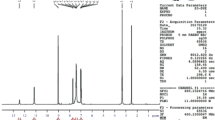Abstract
The effect of ascorbic acid (AA) on the corrosion of mild steel in sulphuric acid solution has been investigated by open circuit potential (OCP) and polarization measurements. AA was observed to shift the OCP to more positive potentials with increasing concentration. The polarization curves revealed that AA inhibited the anodic metal dissolution reaction, although this effect became negligible at high anodic overpotentials. The trend of inhibition efficiency with concentration showed that efficiency increased rapidly at low concentrations, remained almost steady at intermediate concentrations and increased again at high concentrations. The mechanism of inhibition was considered in terms of initial chemisorption of AA according to the Temkin isotherm, followed by formation of chelate compounds with Fe2+ ions at high concentrations. EDS and AFM analyses of the electrode surface support the proposed inhibition mechanisms.









Similar content being viewed by others
References
Shibli SMA, Saji VS (2005) Corros Sci 47:2213
Mu G, Li X (2005) J Coll Interface Sci 289:184
Oguzie EE, Onuoha GN, Onuchukwu AI (2004) Mater Chem Phys 89:305
Oguzie EE, Unaegbu C, Ogukwe CN, Okolue BN, Onuchukwu AI (2004) Mater Chem Phys 84:363
Oguzie EE, Onuoha GN, Onuchukwu AI (2004) Mater Chem Phys 89:305
Harek Y, Larabi L (2004) Kem Ind 53(2):55
Kissi M, Bouklah M, Hammouti B, Benkaddour M (2006) Appl Surf Sci 252:4190
Ameer MA, Khamis E, Al-Senani G (2000) Ads Sci Tech 18(3):177
Christov M, Popova A (2004) Corros Sci 46:1613
Ateya BG, El-Anadouli BE, El-Nizamy FMA (1981) Bull Chem Soc Jpn 54:3517
Jianguo Y, Lin W, Otieno-Alego V, Schweinsberg DP (1995) Corros Sci 37(6):975
Oguzie EE (2006) Mater Chem Phys 99:441
Oguzie EE (2005) Pigmt Res Tech 34:321
Oguzie EE, Iyeh KL, Onuchukwu AI (2006) Bull Electrochem 22(2):63
Gunasekaran G, Chauhan LR (2004) Electrochim Acta 49:4387
Morad MS, El-Hagag A, Hermas A, Abdel Aal MS (2002) J Chem Technol Biotechnol 77:486
Moretti G, Guidi F, Grion G (2004) Corros Sci 46:387
Ochoa N, Moran F, Pebere W, Tribollet B (2005) Corros Sci 47:593
Matos JB, Pereira LP, Agostinho SML, Barcia E, Cordeiro GGO, D’Elia E (2004) J Electroanal Chem 570:91
Zumreoglu-Karan B (2006) Coord Chem Rev 250:2295
Lyman CM, Schultze MO, King CG (1937) J Biol Chem 113:757
Roig MG, Rivera ZS, Kennedy JF (1995) Int J Food Sci Nutr 46:107
Sekine I, Nakahata Y, Tanabe H (1988) Corros Sci 28:987
Nigam AN, Tripathi RP, Jangid ML, Dhoot K, Chacharkar MP (1990) Corros Sci 30:201
Goncalves RS, Mello LD (2001) Corros Sci 43:457
Ferreira ES, Giacomelli C, Giacomelli FC, Spinelli A (2004) Mater Chem Phys 83:129
Cao C (1996) Corros Sci 38:2073
Bockris JO, Swinkels DAJ (1964) J Electrochem Soc 11:736
Popova A, Sokolova E, Raicheva S, Christov M (2003) Corros Sci 45:33
Chikh ZA, Chebabe D, Dermaj A, Hajjaji N, Srhiri A, Montemor MF, Ferreira MGS, Bastos AC (2005) Corros Sci 47:447
Acknowledgements
E. E. Oguzie is grateful to the Chinese Academy of Sciences (CAS) and the Academy of Sciences for the Developing World (TWAS) for the award of CAS-TWAS Fellowship.
Author information
Authors and Affiliations
Corresponding author
Rights and permissions
About this article
Cite this article
Oguzie, E.E., Li, Y. & Wang, F.H. Effect of ascorbic acid on mild steel dissolution in sulphuric acid solution investigated by electrochemical polarization and surface probe techniques. J Appl Electrochem 37, 1183–1190 (2007). https://doi.org/10.1007/s10800-007-9384-3
Received:
Revised:
Accepted:
Published:
Issue Date:
DOI: https://doi.org/10.1007/s10800-007-9384-3



